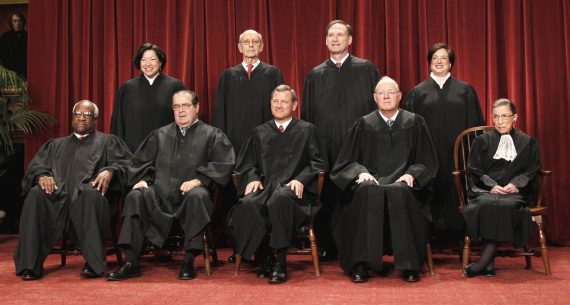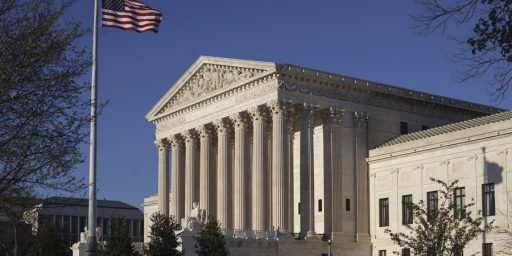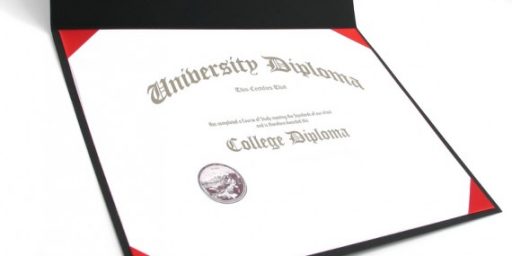Divided Supreme Court Hears Arguments On Affirmative Action In University Admissions
A divided Supreme Court heard argument today in a case involving affirmative action in college admissions that is before the Court for the second time in two years.
Today, the Supreme Court revisited the issue of racial preferences in admissions at public college and universities, and while there appears to be a majority on the court that is skeptical of the Constitutionality of the practice there is yet again a possibility that the Court could end up punting on a case that is already before the Court for the second time:
WASHINGTON — A majority of the Supreme Court justices seemed unpersuaded on Wednesday that an affirmative action plan at the University of Texas was constitutional. But the member of the Supreme Court who almost certainly holds the crucial vote, Justice Anthony M. Kennedy, devoted almost all of his questions to exploring whether the case should be returned to the trial court to allow the university to submit more evidence to justify its use of race in deciding which students to admit.
By the end of the unusually long and tense argument, Justice Kennedy indicated that the Supreme Court might have all the evidence needed to decide the case. That could mean that the Texas admissions plan is in peril and that affirmative action at colleges and universities around the nation may be in trouble as well.
It was the court’s second look at the admissions program at the University of Texas, Austin. The last time, in 2013, the court avoided giving a direct answer about the constitutionality of the program used by the university, and returned the case to an appeals court for reconsideration.
The Supreme Court’s decision to revisit the case this term struck many supporters of affirmative action as an ominous sign, one suggesting that a 12-year-old societal compromise was in peril.
In 2003, in Grutter v. Bollinger, the court said that public colleges and universities could not use a point system to increase minority enrollment but could take race into account in vaguer ways to ensure academic diversity. Though the usual constitutional rule is that the government cannot classify people by race, the 2003 decision said the court would make a limited exception for public colleges and universities for roughly 25 years.
The Grutter case was decided by a 5-to-4 vote, with Justice Sandra Day O’Connor writing for the majority. Diversity, Justice O’Connor wrote, encourages lively classroom discussions, fosters cross-racial harmony and cultivates leaders seen as legitimate. But critics say there is only a weak link between racial and academic diversity.
Justice O’Connor retired in 2006 and was replaced by Justice Samuel A. Alito Jr., who is more conservative.
The Grutter decision allowed but did not require states to take account of race in admissions. Several states, including California and Michigan, forbid the practice, and public universities in those states have had a drop in minority admissions. In other states and at private institutions, officials generally look to race and ethnicity as one factor among many, leading to the admission of significantly more black and Hispanic students than basing the decisions strictly on test scores and grades would.
The new case, Fisher v. University of Texas, No. 14-981, was brought by Abigail Fisher, a white student who says the University of Texas denied her admission in 2008 because of her race. The case has idiosyncrasies that may limit its reach.
In Texas, students in roughly the top 10 percent of high schools are automatically admitted to the University of Texas, Austin. That program does not directly consider race but increases racial diversity largely because many high schools in the state are racially homogeneous. Ms. Fisher, who has since graduated from Louisiana State University, just missed that cutoff at her high school in Sugar Land, Tex., and then entered a separate pool of applicants admitted under the system that is commonplace at most colleges and universities, where race is considered as one factor among many.
The basic question in the case is whether the university was entitled to supplement its race-neutral Top 10 program with a race-conscious holistic one.
When the court last considered Ms. Fisher’s case in 2013, it deferred conclusive action in what appeared to be a compromise decision.
Justice Anthony M. Kennedy, writing for the majority, said the federal appeals court in New Orleans had been insufficiently skeptical of the Texas program.
Colleges and universities, Justice Kennedy wrote, must demonstrate that “available, workable race-neutral alternatives do not suffice” before using race in admissions decisions. The case was sent back to the appeals court. In its second encounter with the case, a divided three-judge panel of the United States Court of Appeals for the Fifth Circuit, in New Orleans, ruled that the Texas admissions plan passed constitutional muster.
Lyle Denniston analyzes today’s argument:
The mystery of why the Supreme Court chose to take a second look at the challenge to the University of Texas at Austin’s consideration of race in choosing new students was partly solved in a prolonged hearing on Wednesday morning. The case, it would appear, now comes down to three options: kill affirmative action nationwide as an experiment that can’t be made to work, kill just the way it is done at the Texas flagship university because it can’t be defended, or give the university one more chance to prove the need for its policy.
The Court bored deeply into the details of the Texas policy, in a hearing lengthened by more than a half-hour beyond the scheduled sixty minutes, and marked by heated exchanges and deep emotions, especially when discussing the academic skills of blacks and Hispanics as university candidates.
Because the first two options that seemed to emerge would be momentous rulings, it may be that the Court would not want to do either with only an eight-member Court. Justice Elena Kagan, because of her past involvement with this very case while a government lawyer, is not taking part, and a shortened bench might not want to act so boldly. But even the Justice who talked most about another chance for the university — Anthony M. Kennedy — did not seem entirely convinced that it would make a difference.
If the Court, after weeks of private deliberation, ultimately cannot assemble a clear five-Justice majority among the eight who will decide, that could lead to a simple order by an evenly divided Court with no opinion but with the practical effect of upholding the Texas program as is. That would provide no guidance for other public colleges and universities. Because no faction among the Justices would seem to want that, there is likely to be a strenuous effort to find a common ground — as there was last time, two years ago, when a seven-to-one decision returned the case to lower courts for another look, with modest new guidance.
There was no doubt on Wednesday that there are three and probably four Justices who have grown deeply skeptical, if not hostile, to affirmative action in general. That would include, for sure, Justices Samuel A. Alito, Jr., Antonin Scalia, and Clarence Thomas. (Although Thomas did not ask any questions today, his views on the issue are well known.). A fourth could be Chief Justice John J. Roberts, Jr., who openly fretted about whether the time would ever come when race would no longer be used in affirmative action on college campuses. He noted that, twelve years ago, the Court had predicted that there would be no need to use race in college admissions within twenty-five years, but about half of that time is now gone.
Equally, there was no doubt that there are three Justices clearly on the university’s side — Justice Ruth Bader Ginsburg, who would have upheld the plan two years ago and was the lone dissenter in that ruling, and Justices Stephen G. Breyer and Sonia Sotomayor. Sotomayor was a dogged questioner of the attorney challenging the Texas plan, Bert W. Rein of Washington, D.C. She was so excitedly involved that, twice, the Chief Justice cut her off in order to let Rein finish a thought.
(…)
One of the constitutional arguments that the challengers are now emphasizing anew, and pressed again on Wednesday, was that the university has been engaging in racial stereotyping by disparaging the academic skills of minority students who graduated in the top ten percent of racially segregated schools in Texas. Both Justice Alito and Justice Scalia, in efforts to defend the top ten percent plan’s success, reacted negatively to that perception of the university’s justification — a justification which the university denies that it has.
But Scalia’s arguments became quite clumsy, and raised some eyebrows, when he suggested that maybe the University of Texas needs fewer minority students, and he suggested that many of them find that the classes are “too fast” for them at such high-rank institutions, and thus prefer to go to lower-ranked, “slower-track schools.”
Garre, the university’s lawyer, responded by reminding Scalia that the Supreme Court had rejected that very type of argument a dozen years ago in the last major ruling to uphold a college affirmative action plan, for the University of Michigan Law School. “Frankly,” Garre said, “I don’t think the solution to the problems with student body diversity can be to set up a system in which not only are minorities going to separate schools, they’re going to inferior schools. . . . Now is not the time and this is not the case to roll back student body diversity in America.”
The remainder of Denniston’s analysis is too long and detailed to be fairly exerepted, so I recommend reading it in full if you’re interested in how the argument went today. To summarize it briefly, though, it does appear that Justice Kennedy, who will likely be the decisive vote in this case no matter which way it goes, may still be reluctant to lower the final hammer on racial preferences in public education as many conservatives are hoping this case will. Because of this, he appeared to at least be exploring the idea of remanding the case, this time to the trial court, to allow the University of Texas to present additional evidence and argument in favor of the justifications it has put forward for the racial preferences program both in this case and the one that preceded it. In order for that to happen, of course, Kennedy would need to get the support of at least four other Justices who would support him in ordering a remand, and he might potentially find that in the four liberal Justices who would prefer to see the program upheld but also recognize that, if Kennedy went with his conservative instincts he would end up voting with Roberts, Scalia, Thomas, and Alito and that would likely result in an opinion that, at the very least would severely restrict the ability of public universities to use race-based preferences of any kind in their admissions processes.
As I always repeat after oral argument in any case, it is important not to draw any conclusions from the way today went because it may not necessarily indicate what individual Justices, never mind a majority of the Court, is actually thinking. Nonetheless, as I’ve said before, this is an issue that the Supreme Court has been dealing with for more than thirty-five years now, and while it has largely danced around the issue, it appears that the Justices have come to the point where they have to confront the issue directly whether they’d like to or not:
The dancing started with Regents of the University of California v. Bakke in 1978. While the Court did not fully reject the idea of race-based admissions policies in Bakke, it also didn’t completely approve it either, a mixed holding that seemed to suggest that universities could have policies that took race and ethnicity into account but that anything that resembling quotas. The problem was that the opinion wasn’t very specific about where the difference between permissible race conscious and impermissible quotas might actually lie. What followed theBakke decision was a long era in which admissions authorities tried to determine what exactly is acceptable under the 14th Amendment’s Equal Protection Clause which, as a general rule, bars race-based discrimination by government entities, including public universities. The Court didn’t provide much guidance on the issue in the intervening years until a 2003 case called Grutter v. Bollinger where the Court upheld an affirmative action policy in place at the University of Michigan Law School that used race as a factor with the purported goal of increasing class diversity. The decision still didn’t necessarily resolve many of the questions left by Bakke and it especially left many conservatives unsatisfied to the point where many hoped that the opportunity to deal with the issue head-on would finally arrive once Justice Sandra Day O’Connor, who was the deciding vote in Grutter, retired.
(…)
One anticipates that the Justices won’t be able to punt this case as they did in 2013, so there’s going to be some kind of ruling on the merits. In that respect, it’s important to note that Justice Kagan will once again not be participating in the consideration of this case given the fact that she was involved with the Federal Government’s handling of it when she served as Solicitor General before being elevated to the Court. Strictly from a nose counting perspective, this would seem to be bad news for the University of Texas since Kagan would be expected to vote with Justices Ginsburg, Sotomayor, and Breyer on the underlying issues in these cases and Justice Kennedy has previously expressed skepticism over race-based admissions programs as evidenced by the fact that he was in the minority in Grutter that would have struck down the University of Michigan’s program. This is the same dynamic that existed the last time the Court heard the case, of course, so its unclear what that means going forward, but it seems likely that a decision that restricts Grutter or even overturns it outright is not beyond the realm of possibility.
While it’s still early in the term, it’s likely that this is a case that the Justices will be debating back and forth for some time as they try to craft an opinion. Because of that, I would not expect an opinion before we get closer to the end of the term in June. The only way we’d be likely to get a decision earlier, I would think, would be if the Court decided to punt the case back to the District Court yet again, but given the fact that these Justices know that the case would ultimately be back before them for a third time sometime in the next two or three years they may just be eager to get it over with already and issue a final decision. So, stay tuned.
Here’s the transcript of today’s oral argument:







Forgive my ignorance on how these legal proceedings work but doesn’t the plaintiff have to win on her merits, i.e. demonstrate that using race as a factor actually discriminated against her. I think it has been shown that she didn’t qualify even if race was not used as a factor. Or can the Supreme Court consider this case in the theoretical abstract and issue a ruling not specific to this case?
Personally, I think socioeconomic status could be used just as effectively as a diversifying agent and avoid the emotion of the racial discussion.
I think this presidential campaign has shown rather starkly that there is no longer even a hint of racial or ethnic animus in this country.
@Scott:
That’s effectively what the Texas law does, Scott. It requires UT to accept anyone who graduated in the top 10% of his or her high school class to be accepted.
@Scott: I love all this back and forth on affirmative action and everyone carefully avoids the REAL elephant in the dining room–to wit, the incredible advantages the son or daughter of an alum has in applications. Especially alums that donate large amounts of $$$ to the university.
If we’re going to bitch about anything, we should be bitching about that.
Well, if anyone ever wanted to figure out what “affirmative action” in public schooling actually has accomplished, in real life, not in fantasy land, all one would need to do is to check out the race-based dichotomies in employment. Unemployment for whites stands at 4.3%. For blacks it’s at 9.4%. Pretty much the same deltas as two or even three decades ago.
The other useful tool, although this wouldn’t generally apply to blog demographics, because so little thereof have any connection to the private sectors, is to just do a rough head count around a private medical office, or a law office, or an engineering office, or an accountancy firm. Financial services. Real estate. Doesn’t matter, actually, the profession. Any professional workplace in the private sector. Where real people work in real jobs and earn legit wages and benefits. Count up the number of racial minorities you see. Apply as a percentage to the total head count. Compare to the population at large. Connect the obvious dots.
@Bill Lefrak: I guess I just imagined all those black students in my classes at MIT and in law school, huh?
You really state idiotic things.
@Bill Lefrak:
Connect the dots for us. I truly don’t know what you are trying to say or imply.
@grumpy realist: Yes, legacy admissions are a form of affirmative action although I don’t know whether that is a big factor in public universities.
The main factor in admission should be academics, not race, or even sex . The application should not even denote a person’s race or sex. Let’s get some common sense and integrity here.
@Dave Schuler: As a general rule, I think that the top 10% rule can be a rough equalizer between individual schools and school districts, urban vs suburban vs. rural, small vs large. There is a huge variation between academic opportunities between school based on size, resources, and location. There is even variation on grading and how to score the grade. Example, AP courses at my son’s high school is given 1.25 multiplier. There is huge amount of AP courses available. As a result, his GPA is 108, which is top 7%. BTW, UT is top 8% admittance due to demand. If UT used top 10%, there would be no discretionary admittances.
@Tyrell: What about a case where a university can show, via hard data, there’s a link between SAT scores and GPA? And that the SAT scores underpredict how female students do in classes by half a grade?
Would you use this as a factor in comparing SATs of entering students, or just ignore it?
@Tyrell: Theoretically I would agree but the question then becomes: How do you measure academics? Is it test scores? Grades? A portfolio of high school work? What do college essays have to do with admission? How would you handle high school activities like sports, band, theatre, debate, etc.? How about economic background? You still have judgement calls. It should never be a mechanical process even at the risk of perceived fairness. As they say, life isn’t fair.
@grumpy realist: As well as taking into account that SAT scores are highly coorelated with family income.
What LeFrak is saying is that you don’t find African-Americans in professional jobs because they’re racially inferior and incapable of performing work that requires intelligence. The inference is that admitting them preferentially to universities, or maybe admitting them at all, is a mistake because it uses up resources that could better be applied to the education of whites and (maybe) Asians. Besides, it frustrates them when they get into situations they can’t cope with, and it makes them lash out at great Americans like John C. Calhoun, he of the Yale residential college. The only people who favor affirmative action are trust fund types, identifiable because they eat a lot of brie in between sipping cabernet.
Keep it up, LeFrak. I really love posts by a guy who thinks brie is snooty.
@Stan: Amazing how 99% of so called “race realists” are pasty white dudes who haven’t accomplished diddlely-squat in their lives and spend most of their time writing racist screeds on the internet and send them to each other. The Stormfront and Vdare types.
As I’ve mentioned before, one of the most brilliant theoretical physicists I know is of a skin colour that makes President Obama look white. He must be terrifying to the “race realist” types, because he demonstrates exactly what they are–losers who don’t have the brainpower to accomplish anything.
@Dave Schuler:
And she wasn’t in the top 10%. Despite that, the idea that anyone who graduates in the top 10% should be automatically be accepted at any state school has been more than problematic.
I’m not sure how admissions should be evaluated but I am certain the professionals in academia are more suited to decide than the masses.
It really is interesting how affirmative action cases always focus on an aggrieved white student who was passed over (denied admission) in favor of supposedly less qualified Black or Hispanic applicants. It always seems that the denied White applicant was never passed over because less qualified White students were admitted ahead of him/her. Why is that?
We know why, never mind.
@Scott: And it is even more convoluted, because both UT and A&M fall under the 10% Rule, so neither one can truly know how many guaranteed admissions they have to carve out before they can start offering discretionary admissions.
And, to make it even more fun, you have schools like Round Rock – Westwood which is the International Baccalaureate campus for the entire ISD, pushing almost all of the geographical zoning students who don’t qualify for a magnet campus out of Top 10% contention.
@Dave Schuler: Ok, I’ll bite, what percentage of economically disadvantaged kids graduate in the top ten percent of the class?
@Stan: Aren’t all things French snooty?
@Just ‘nutha ig’rant cracker:
In Texas (as in Chicago and much of the country) there are patterns of residence, poverty, and race. Since as a general matter you go to the school closest to you, the kids with whom you attend school tend to be similar to you in income and in race. Poor kids go to school with other poor kids. Black kids go to school with other black kids. And so on.
In other words, the answer to your question is 10%.
@Just ‘nutha ig’rant cracker: At a campus that is geographically zoned entirely within an economically disadvantaged area, close to 100%.
@al-Ameda:
You mean like the football or basketball team??
One man, one vote. One dark skinned man……..7 ft tall. One admission and basketball scholarship.
@Tyrell: you are considering admissions from the perspective of the student, not the school. There is a value to the school, and the overall student body, to have a somewhat diverse class.
Scalia, unsurprisingly given his complete lack of empathy, made racist-tinged comments during oral argument that are making the rounds on social media. It’s not a good look.
@Stan:
Hey, whaddya mean “maybe”? It should be “of course”! There’s no racism left, because those Orientals work hard and they do fine!
@SKI: He didn’t express that as his own view. His question started with “There are those that say…”, citing student performance disparities at more selective colleges. Read the transcript and don’t believe everything that makes the rounds on social media.
Uh-huh…
Ohhhh…so Abigail Fisher was treated unfairly because scholarships are given to athletic minorities? Or perhaps the fact those scholarships are given equals out legacy admissions? Do tell…
@Scott: There was a wisecrack that made the rounds when I was a grad student at Yale: “Legacies walk with their noses in the air; grad students are the ones who act like they’ve been horsewhipped.” That is one of several gorillas in the room when admission to college is under debate.
@Guarneri:
Okay, I’ll play along. Do you feel that the great majority of college athletes are less qualified for admission than most others admitted? Or is it non-White ‘student-athletes’ that are less qualified?
@Moderate Mom: (a) “There are some that say” is a classic dodge of responsibility used all the time. There was no point of bringing it up unless he wants to get the thought out there.
(b) I know what and how he said it, that is why I said “racist-tinged” not flat out racist.
(c) it isn’t a question of reading the transcript or believing things. The fact that it is making the rounds on social media is a big problem for SCOTUS’s credibility as an institution. Perception matters – and Scalia is very well aware of it.
@Moderate Mom: There are those who contend that you chose the screen name Moderate Mom in an attempt to obfuscate the fact that you’re actually a right wing nut job, and make your extremist arguments sound more reasonable.
[This is fun!]
@Gromitt Gunn: The reason that I asked is that in my experience, the type of distribution you hypothesize simply doesn’t happen. For example, in Seattle, there are blighted neighborhoods in virtually every high school zone in the city and even the one large contiguous “ghetto area” was divided among 3 high schools with surrounding middle class neighbors. I was hoping that someone might know some actual data.
Heh! Perfect response from Andy Borowitz:
http://www.newyorker.com/humor/borowitz-report/study-scalia-better-off-in-less-advanced-court?intcid=mod-latest
@Bill Lefrak:
Um, in engineering there are considerable numbers of minorities … in fact, according to numbers released in silicon valley, whites are more or less the same hired at their percentage of the population.
This is in line with what I saw in engineering at university, and what I’ve seen working as an engineer.
@george: It also depends where you are. I’ve got a friend from Uganda who I met while he was doing his doctoral work here and who is now at John Hopkins.
Anyone who thinks there aren’t any dark-skinned Ph.Ds in science hasn’t looked that far. And just going over the ethnicity of people in my law firm, we’ve got a pretty fair paralleling of percentage in society.
Sorry to disappoint all the pasty-white Vdare types, but that really is how it goes. Your continued problems in getting anywhere in life aren’t due to any great vague conspiracy against white males–the one consistent factor in your failures is your own self.